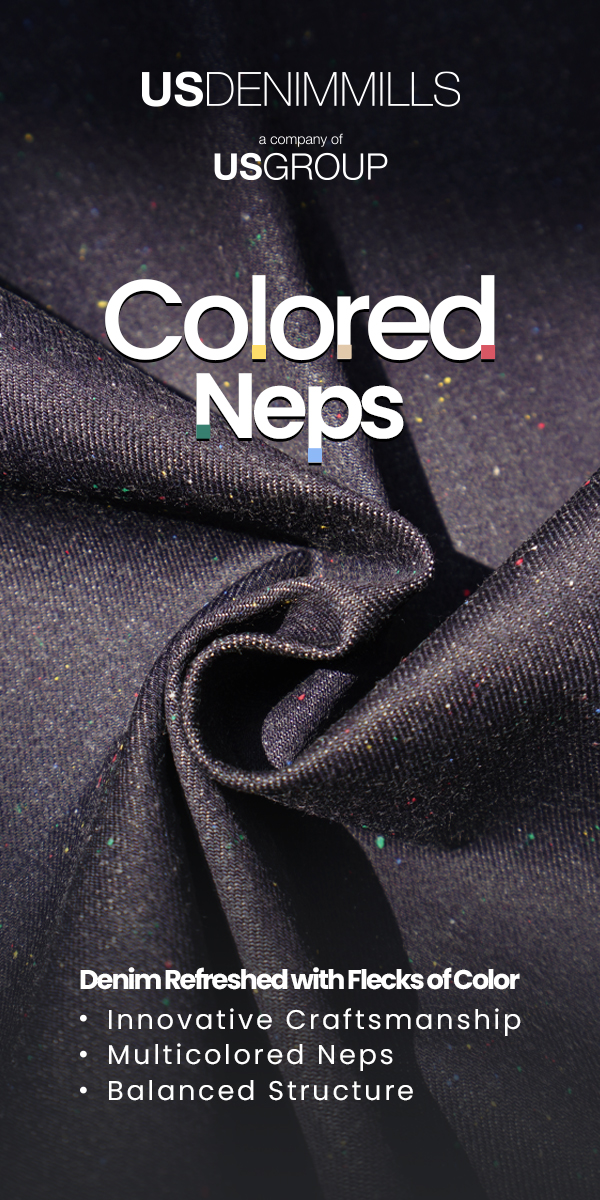No place like home

A community project in the north of England that aims to grow and process flax through to dyed, finished linen could result in very exclusive jeans. It could also inspire a wider revival of textile and clothing manufacturing at a local level.
Clothing entrepreneur, designer and television personality Patrick Grant is backing a community textile project in Blackburn that aims to prove that locally made apparel from locally grown textiles and natural dyestuff is still possible in the UK in 2021. Homegrown Homespun is a regenerative fashion project that has grown out of a wider arts programme in this part of northern England called Super Slow Way. In spring 2021, with the support of Patrick Grant, volunteers cleared an area of land and began growing flax on it, leaving space for woad and other plants that can provide natural dyes.
Hardy volunteers have gone every Friday since then, in sunshine and in rain, to look after the plot, which was donated to the project by the local council. The land, situated close to a wooded area near the Leeds-Liverpool canal, was disused and overgrown, but the Homegrown Homespun team cleared it, fenced it off neatly (with the help of students from Blackburn College), tilled, drilled, seeded and weeded it until, in the middle of August, the flax was ready for pulling, retting, spinning and weaving. Volunteers have included people of all ages from all parts of the region and the project, from the outset, has been open to everyone. It is close to Blackburn railway station and one of the Super Slow Way directors, Jenny Rutter, says there are plans to cut walkways between the flax field and the Leeds-Liverpool canal, which would allow local runners, walkers and cyclists to make a very quick detour from the towpath to see the site.
Northern stories
Super Slow Way takes its name from the canal; Yorkshire poet Ian McMillan gave it this title in a short poem from 2016, which he wrote to commemorate the 200th anniversary of the canal’s completion. He talks about the waterway as a conduit for “our tales, our Northern stories”. The programme focuses on the communities that grew up beside the canal, or at least the stretch of it that spans the 25 kilometres or so between Pendle and Blackburn.
Jenny Rutter immediately loved the idea of featuring textiles and clothing produced by local communities. “There used to be 100,000 looms in Burnley [one of the towns in her area] alone,” she explains. “Manchester was the showcase for clothes and fabrics, but all the spinning and weaving happened here. The climate is suited to it because it’s damp here, making fires in the mills less likely. That’s also why people wore wooden clogs in the mills; boots with hobnails could spark and cause fires. All of these things, the mills, the cloth and the clogs, are part of our local heritage.”
Super Slow Way’s aim is to use arts and culture projects to help people stay connected to the whole of that heritage, including textiles. “The textile industry is here because the canal is here and our communities are as diverse as they are thanks to the textile industry,” Ms Rutter says.
Local sourcing
No irrigation was required to produce Homegrown Homespun’s special crop in this rainy part of the world and the team used no fertiliser either. North West England Fibreshed, another of the driving forces behind the project, would have wanted the field to fill with flax in no other way. A community of textile producers and educators who champion regeneratively grown materials, Fibreshed is a non-profit organisation that launched in California in 2010. Founder, Rebecca Burgess, set out to develop, for her own use, a wardrobe of garments whose fibres, dyes and labour were sourced entirely from her home region. She explained that she wanted to reduce her ecological footprint, so she teamed up with farmers and artisans who were no more than 250 kilometres from her home in Fairfax, to the north of San Francisco, to source clothing in a super slow way.
First project
Her idea has spread and there are now Fibreshed communities across the US and Canada, as well as in Denmark, Finland, Germany and India. There are four in the United Kingdom, including the North West England Fibreshed, set up by Wirral-based textile dyeing specialist Justine Aldersey-Williams in 2020. Homegrown Homespun is this Fibreshed community’s first project, with Ms Aldersey-Williams organising workshops from the outset to help local people increase their knowledge of fibres, spinning, weaving and dyeing. At the time of a Inside Denim visit, one wet summer Friday, this included an impromptu demonstration of the effects of woad on a small, white, silk handkerchief. There is a dye garden just in front of the flax field with, in addition to woad, marigolds for yellow dye, hollyhocks for purple, madder and lady’s bedstraw for red.
For the purposes of the demonstration, she picked woad leaves from the plot and placed them in a metal salad bowl. She then worked the leaves with her hand for a time, almost as though she were kneading dough for bread, before adding the handkerchief to the mix. It quickly turned green, but the colour would soon change to blue, with exposure to oxygen.
Justine Aldersey-Williams and Patrick Grant together came up with this initiative. She knew him to be as passionate about locally sourced and produced clothes as she is and, because he is a judge on a BBC television programme that showcases and celebrates the sewing skills of members of the public, his involvement has helped attract wider interest.
Community concerns
Mr Grant’s own business interests include high-end, London-based tailoring and menswear brands Norton & Sons and E. Tautz & Sons. In recent years, he has also taken over the Cookson & Clegg Clothing Company, which makes jeans at a factory in Blackburn, and set up a social enterprise called Community Clothing, which is also based in the Lancashire city. It aims to produce UK-made clothing and to connect with communities in which clothing and textiles play, or have played, a significant role. With Community Clothing, Mr Grant, who lives near Blackburn, aims to design and make “simple ranges of clothing for men and women” using the fruits of these communities’ labour.
Another motivation for Community Clothing is to highlight the state of play that has emerged on UK high streets (and elsewhere). “The market price for clothing has fallen dramatically in the last two decades,” Mr Grant said on setting up Community Clothing, “as a result of retailers moving their manufacturing offshore.” But he said the same retailers, driven by shareholders’ desire for profit, continue to demand high margins, and the prices they charge consumers reflect this. Garments from UK-based manufacturers would command even higher prices, but not high enough to make most of these businesses viable owing to the small volumes retailers want to stock. All that is left to these local manufacturers, according to him, is “smaller-volume, seasonal production for the higher-end fashion industry”. In most cases, this is work for specific times of the year only, leading to a lot of what he calls “seasonal hiring and firing” of garment workers. In some cases, people are even being paid “wages below the legal minimum”, he claims. His idea is to have skilled workers make Community Clothing’s collections during otherwise “quiet production periods”; Mr Grant’s community interest company will sell these clothes directly to the public. “We can keep prices affordable and sell large volumes,” he says.
Turn the clock back
Speaking on the same theme on BBC Radio in June, Patrick Grant said: “The textile system we have now, as lots of us know, is pretty damaging to the environment. We want to turn the clock back to a system that existed a few hundred years ago when everything was produced locally and people in the community got involved.”All of this helps explain his involvement in Homegrown Homespun. He describes flax as “an amazing plant that just springs to life” (in the right geographies). His specific aim is to use the locally grown linen fibres from the project to make, through Community Clothing, some jeans. What he makes will then go on show at an exhibition called the British Textile Biennial this autumn. “We want to prove the concept,” Mr Grant says, “and if the concept works we’ll roll it out in a bigger way. We want to regenerate sustainable clothing and to create jobs. We want to encourage people to move away from having bad materials in their clothes to using good, climate-positive materials instead.”
This chimes completely with the views of Justine Aldersey-Williams. “It’s simple,” she says. “We have to choose between clothing from above the ground and clothing from below the ground.” This same thought is part of her manifesto for North West England Fibreshed, in which she calls for a transition from extractive textile manufacturing processes to more regenerative systems. Anything that moves us away from fossil fuels is positive in her book, even if it is only in a (super) slow way. She’s not aiming to end greenwashing in the global fashion industry, saying with a shrug: “I don’t think greenwashing will ever stop. People who tell lies will keep telling lies. Nothing will change them. For some of us, though, there is a better way. We can live with less and make things that last longer.”
Start small
Homegrown Homespun’s initial ambitions are deliberately conservative and the team will be happy even with just one pair of Patrick Grant jeans from this inaugural crop. “We calculated conservatively because we wondered about crop failure and other factors,” Ms Aldersey-Williams says, “but we will have more than enough. The flax you can grow in 15 square-metres of land will give enough linen to make one pair of jeans. We have 300 or 400 square-metres here.” The whole point is to make a start and show that the Homegrown Homespun idea can bear fruit. “Starting with a single pair of jeans, she explains, “we will build a whole network of people who will grow flax in their gardens, their allotments or fields like this one. We will have people who can process the fibres, make spun yarn and weave fabric. These crafts have not been valued or taken seriously because they were women’s work. That needs to change. These are activities that connect us to the earth.”
If the project team is able to expand Homegrown Homespun, what it envisages is something that could emulate the way Harris Tweed works in Scotland. Harris Tweed is woven from 100% pure new wool yarn that must, by law, have been dyed and spun in the Outer Hebrides, the most remote of the inhabited isles off the west coast of Scotland. The yarn must be woven by hand in the homes of islanders. At the moment, there are 220 weavers throughout the islands collectively producing between 1 million and 1.5 million metres of Harris Tweed fabric per year. These people often have other jobs, too, such as looking after land and livestock, but weaving a fabric that is in great demand the world over provides an important supplementary income throughout the year.
Justine Aldersey-Williams, Jenny Rutter and Patrick Grant believe that something similar could flourish in Lancashire as a result of Homegrown Homespun, with a real flax, linen and clothing cottage-industry building up there. It will not challenge fast fashion, but it will show that a slower, alternative way is possible.
Cut and dried. The project’s aim goes beyond one crop of flax and one pair of linen jeans to a revival of locally produced fibre, fabric and clothing in Lancashire.
Photo: Justine Aldersley-Williams













